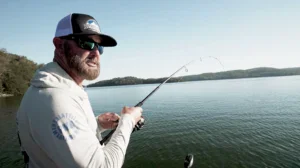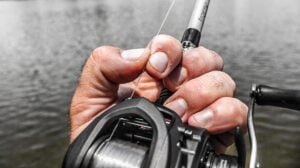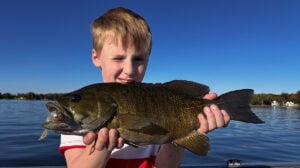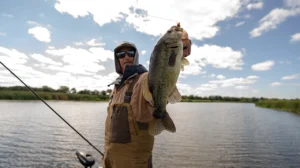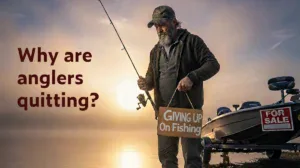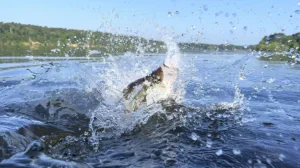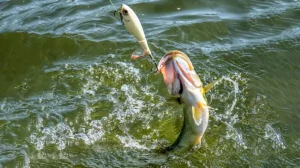There comes a time every year when you just have to slow down out on the water. That time of year when you have to defrost your compartment latches just to get to your tackle. When every fifth cast is spent popping little ice pellets from your rod guides. When a frog’s only business in your boat is to remind you of warmer days and that there are more to come.
But don’t let the short days and cold weather get you down. The fish are still in the water, as frigid as it may be. And they still have to eat. You just have to change your offering and sometimes where you look. Although there’s a plethora of techniques that will produce in the winter, one of the most tried and true is finesse cranking.
The tight, subtle action of a finesse crankbait is preferable to the wider wobbling baits we use in warmer water situations primarily because the fish are so lethargic. With less going on around them, a lighter vibration can be detected and loud, intrusive baits can spook fish where they would have triggered a strike in the summer months.
The tactic works extremely well on lakes with a lot of rock and a little stain to the water, which is one reason Straight Talk pro Scott Canterbury relies heavily on the method in the winter months. Fish can and have been caught finesse cranking all over the country, but it’s Canterbury’s home lake of Logan Martin that instilled a love for baits like the Rapala Shad Rap in him at an early age.
Having used the technique to catch a dump truck load of Coosa River spotted bass on Logan Martin alone, Canterbury has developed a keen eye for when and where to utilize the baits. On the rougher winter days with low light, the bass setup on the steeper 45 degree banks where he brings the boat in a little tighter to the bank in order to get the most from each cast.
By bringing the boat in tight, Canterbury is able to keep contact with the steep embankment longer by making more parallel casts down the bank rather than perpendicular to the bank. Although finesse crankbaits come in various sizes that dive to different depths, his bait of choice is a Jackall Soul Shad 68SP which dives 4 to 6 feet. Keeping contact with bottom is crucial since the bass are typically relating to it in the winter time.
Reason being, the rock along the bottom warms up as the day wears on, and the bass use this heat to regulate their own body temperatures. In addition, the bottom is where you’ll find a lot of the food during the late winter months. As the water cools it becomes too much for the shad too endure and they begin to die off, falling to the bottom.
If the sun is out however, bass will move up to the shallow, flatter points where they can warm in the shallow sunlit waters and actively feed. Contact with the bottom is still important but typically implied due to the depth. Finding road beds and shallow water humps others often overlook has led to some of the better honey holes for Canterbury.
Two tools that he uses to find these areas are his Lowrance HDS 10 and his Typhoon Optics. A quality GPS and a good pair of sunglasses will lead the way to some premier fishing in the winter time, especially on a reservoir that is dropped to winter pool when not all water hazards are marked with buoys. They’ll also prevent the unfortunate mishap of locating a winter pool roadbed with the lower unit.
The shades can also reveal submerged brush piles along docks or logs and laydowns on the rocky banks. Any cover can hold fish in the wintertime according to Canterbury and should be picked clean before moving on.
A slight breeze in both sunny and cloudy conditions helps the bite but a stiff wind can really hinder the casting of these traditionally lightweight baits. Wind is one reason that Canterbury favors the Soul Shad.
“Jackall added a weight system to the Soul Shad that helps a lot,” Canterbury said. “I can throw this thing twice as far as other crankbaits.”
Although twice as far might be a stretch, a weight-transfer system definitely provides advantages. A single ball weight moves freely within a chamber along the belly of the bait. When the bait is tilted forward, the weight comes in contact with a magnet at the front of the chamber. The weight is held there to balance the bait until it is dislodged in the back cast when it loads up in the rear of the chamber and helps propel the bait. This system is a pretty nifty solution to casting light baits in the wind.
Color choice when finesse cranking comes down to forage as it does with any other bait. Keep in mind that you’re not necessarily mimicking a shad. There are numerous finesse crankbaits which are painted in crawfish patterns that work extremely well when bass are targeting the little lobster-like crustaceans instead.
If the fish are relating to shad in the clearer water conditions, stick to something a little more natural like a shad pattern. Loud colors like orange and chartreuse seem to work best in muddier conditions. The muddier the water the more contrast is needed in the color of the bait. However, due to the light action of the lures the water can be too muddy entirely for the technique.
Retrieve is key as well when using a bait like the Soul Shad. Once contact is made with the bottom the trick is reeling it just fast enough to maintain contact. The fish are lethargic for the most part so they aren’t likely to chase bait very far or very fast. If you have a hard time slowing your retrieve, the best remedy is a slow geared reel. Employing a 5.1:1 Abu Garcia Revo is Canterbury’s solution.
Using 8- to 10-pound test Berkley 100 Percent Fluorocarbon line helps Canterbury gain a little more depth and maintain contact with the bottom when throwing a finesse crankbait. A 7-foot, medium-action rod is preferred to prevent losing the fish that often times only get the back hook due to a sluggish strike.
All the pieces are needed to complete the puzzle. The retrieve is slow and the bait stays stuck to the bottom; this will result in some awesome fishing in cold winter months. Don’t go crazy with color choice until the water clarity forces your hand, and be sure to work every piece of cover where the fish can still relate to the bottom. There’s no need to dread the winter. Finesse cranking can turn a drab winter day into a fish filled phenomenal one if you just take the time to apply these tips to your local fishery.



